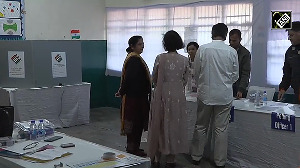This week, Tiger Airways announced the launch of its services from Singapore to Chennai and Kochi with a one-way, basic introductory fare of only Rs 1,599, or more likely just under Rs 10,000 for a return flight, including all taxes.
Nok Air is here with connections to Bangkok from Bangalore for as low as Rs 11,000. And an additional Rs 5,500 will buy you a return fare between Bangkok and Phuket, including two nights' accommodation at a hotel there. Or you might choose to fly Jazeera Airways on a shopping binge to Dubai for a return fare of Rs 10,500.
If that sounds exciting, wait for the whole bouquet of offers coming your way. Thanks to low-cost international airlines, Indians will fly cheaper and more frequently, particularly to destinations within Asia. Besides Tiger Airways, Nok Air and Jazeera, other players in the fray include RAK Airways and Sama Airways -- and that's not counting the homegrown carriers which will compete for air passengers at similar, if not cheaper, fares.
All this because low-cost carriers are taking advantage of India's liberal air agreements to connect the country with destinations in South-east Asia and the Gulf. At a time when consolidation in Indian skies (Air India-Indian, Jet-Sahara and Air Deccan-Kingfisher) could see a strengthening in prices, the new flush of arrivals is a welcome signal for Indian passengers.
Says G R Gopinath, executive chairman of Air Deccan, who is constrained by government policy from flying abroad, "We will see a replay of what happened in the domestic skies being repeated in the international skies." His forecasting comes with a codicil: domestic tariffs could rise by Rs 500-1,000, even as international fares plummet to an all-time low.
The impediment to his -- and Vijay Mallya's -- flying abroad is based on a policy that requires a domestic carrier to have been in operation for five years before it can apply for a licence to fly abroad. But the good news is that the government is re-considering the barrier, and if removed, it would help everyone from Air Deccan to SpiceJet and IndiGo to compete on international air routes. That's when the market will really explode.
Already, the coming months will see the new entrants add 100-odd flights a week to the gateway metros as well as to Kochi, Nagpur, Amritsar and Kozhikode.
From the Gulf itself, where 40,000 seats are on offer every week to India, experts say the new rush will lead to an expansion in capacity by 25 per cent or 10,000 new seats being added by the summer of 2008. And Dubai -- one of the hottest destinations from India -- could experience a 33 per cent increase in capacity in the next 12 months.
That's not counting the private domestic carriers which, when permitted, could take capacity up further. Says a senior Jet Airways executive, "The Gulf market is unexploited and, at the right price, can grow by as much as 100 per cent."
Look eastwards and it's no different. Nok Air has already finalised a four-fold increase in the number of flights into India from Bangkok by next summer -- to 28 flights a week. In just a year, it is chasing Thai Airways 31 flights a week from India. Strategically, it is positioning itself as a shoppers' airline, leveraging its relationship with large malls in Thailand.
Says Nok Air CEO Patee Sarasin, "We price our tickets at 10 per cent less than Thai Airways and have tie-ups with several malls and brands. A passenger carrying a Nok Air boarding card gets a 70 per cent discount in some retail outlets."
Tiger Airways has just received permission to fly to seven destinations in India. And Air Asia, run by maverick CEO Tony Ferandes who kicked off low-cost airlines in South-east Asia, is also making a beeline to India.
"The Indian market is very, very sexy with a billion people and great cities. We would love to fly a Punjabi Express to Amritsar," he chortles. "Of course, Kolkata, Kochi and Bangalore are great cities to operate to, and low fares are the answer for India."
What is making the Gulf and South-east Asian routes even more attractive is the expectation that tariffs will tank further. "There could be a price war," points out Wolfgang Prock-Schauer, CEO of Jet Airways, "but it will be for a new flying population."
It is something that Gopinath, who sees tariffs crashing by half and lower middle class customers expanding the market, is in synch with.
Travel portal CEO Dhruv Shringi of yatra.com says there is scope for tariffs to fall further. "In the Gulf and in the East, the difference between a full-fare airline and a low-cost carrier is 25-27 per cent, which offers leeway for prices to drop further. I see tariffs in the East going down by another 10-12 per cent."
Typically, these low-cost airlines have piggybacked on two important factors: ownership, and fuel cost. Most are promoted by full-fare airlines -- for instance, Tiger Airways is promoted by Singapore Airlines and Nok Air is part-owned by Thai Airways -- helping to bridge the gap between differential fare paying passengers. And aviation fuel or ATF is usually cheaper there than in India. This places the Indian carriers, once they start international low-fare operations, at a disadvantage.
Take the case of Nok Air, the ATF contributing only 15-20 per cent to its running cost. In comparison, fuel comprises 40 per cent of the cost in India. In the oil-rich Gulf states, aviation fuel prices are cheaper even than Malaysia. Admits Air India chairman V Thulasidas, "ATF prices in India should come down, else Indian carriers will remain at a tremendous disadvantage."
Aviation minister Praful Patel is making a belated attempt to resolve the problem by permitting hedging in oil for carriers flying abroad, and by allowing private sector companies to sell ATF fuel to bring down costs and end state-owned oil monopoly in this area. How much of a difference that makes remains to be seen.
Low-cost carriers abroad have some other advantages too, such as a large network within the region. Nok Air can connect you to over 11 destinations within Thailand seamlessly; Jet cannot.
Says a senior executive of Nok Air: "This is a major USP for us." Malaysia-based Air Asia offers networking throughout South-east Asia, linking countries like Vietnam, Thailand, Singapore, Indonesia and Hong Kong, hard put to match by any Indian carrier.
Another advantage even full fare airline companies enjoy is the luxury to drop fares on the India leg, something that is possible because a large percentage of their passengers from India are actually flying onwards to the US or UK. Points out an aviation expert: "There is nothing to stop, say, Singapore Airlines from dropping fares from India to Singapore as it can make up for it on the Singapore-US East Coast routes."
The international low-cost carriers are penetrating the market aggressively, opting for point-to-point services to smaller Indian cities. RAK Airways, for instance, is flying to Kochi and Thiruvananthapuram, while Tiger Airways will fly to Goa, Kozhikode and Kochi, eliminating the need for passengers to travel to the metros for their connections.
On the other hand, domestic carriers like Jet Airways say they can leverage multi-city, point-to-point services from India as their strength. Says Schauer, "Jet Airways can leverage its domestic network and fly passengers to Delhi or Mumbai for their international flights."
The consolidation in Indian skies that will result in domestic passengers paying anything between 10 and 25 per cent more in fares could make bottomlines healthy enough to take on the international competition. Says Vijay Mallya, who has picked up a 26 per cent stake in Air Deccan, "Indian air travellers can afford to pay slightly more, so prices will stabilise and no low-cost carrier will sell below cost."
Whatever else happens, the impending opening up of the Gulf routes to domestic (and especially low-cost) carriers could attack Air India's monopoly in the region, especially for its low-cost subsidiary, Air India Express. Gopinath has been quick to attack the government for its Air India-Indian "cartelisation" and monopoly on the route. With 25-30 per cent of Air India's revenue coming from the Gulf routes, the impact could be significant.
"We agree there will be a price war and pressure on yields," agrees S Venkat, executive director-finance in the airline, "but most international low-cost carriers will not be able to offer fare levels below breakeven point over a long time." To combat this, Air India is banking on its key strengths -- its first-mover advantage in the low-cost market (AI Express has fares up to 50 per cent lower than other international carriers), and its leverage in the domestic market with Indian to provide it an unmatched network.
While these airlines evolve strategies and price cuts to attract more passengers, you can count on flying the cheapest fares to destinations abroad practically on whim. At least till the party lasts.
| INEXPENSIVE, NOT CHEAP!
Nok Air CEO, Patee Sarasin, currently with operations to Bangalore, on the airline's plans in India What destinations are you looking at in India? What will your pricing strategy be? What kind of passenger load factor are you expecting? Are you planning to increase capacity? Will your passenger base eat into parent airline Thai Airways? What is the growth of aviation traffic in South-east Asia? |
| NOTHING TO WORRY ABOUT!
Vasudevan Thulasidas, chairman and managing director, on Air India's focus How will international low-cost carriers impact Air India, particularly on Gulf and South-east Asian routes? What is Air India's strategy for taking on these budget carriers? Do you foresee a fare war? Do lower ATF prices enable foreign carriers to offer cheaper fares? What will be the impact of international low-cost carriers subsidising their Indian operations? |
| FARE WELL How the fares stack up
|







 © 2025
© 2025